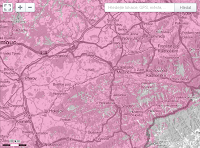This is a description of the initial solution I had for finding my payload after the flight. At that time, I wanted to do the tracking as trivially as possible. So once again inspired by an article about an iPhone tracked balloon, I decided to head in this direction. The phone I had at hand was my HTC HD2 powered by Windows Mobile 6.5 system. Although, I was already using a GPS app to track my runs and bike rides, I had to search for an app that was able to send the GPS coordinate via SMS to another phone and to do so automatically. Some time with Google search eventually led me to an app called ReliRescue. It was capable of acquiring the current GPS position and based on the preset interval periodically sending SMS messages to a selected number. Exactly what I needed.
And here is the received SMS message.
Naturally, I first did a couple of tests. The most important question for me was whether the app can keep functioning even when the phone loses either the GPS signal or the GSM signal. From what I understand, the GSM signal reaches to an altitude of 2 km at best and the GPS signal is altitude restricted as well depending on the device used. (In a later article I will describe a GPS module that with the right settings is able to function up to 50 km above sea level.)
This is a map of the signal coverage of my phone provider. This was something to take into account when choosing the right wind conditions for the flight. Ideally, the balloon's predicted landing site should lie in an area covered by the signal. In this case, I used it for my testing as well. I chose some spots without the signal close to my home and rode there on my bike. Turning on the app, I kept riding in and out of the signalless area and observed it's behavior. The app functioned fine, so I proceeded to testing the GPS signal.With that I simply turned the app on, went to the basement and put the phone into a freezer where it lost the signal. Then I went out again and saw the app acquiring the position again thus confirming its functionality.
One more app I intended to use in the flight was GPS Cycle Computer. As I said, I use this app to track my runs and bike rides and in the same way I wanted to use it to track the balloon's trajectory. Because with the ReliRescue app, I would only get the final landing position without ever discovering where the balloon was during its flight.
With all the tests done, the flight would go like this. I would turn on the apps. Set the SMS sending cycle to, let's say, 15 minutes. Wait for the first SMS to arrive to verify that everything is working as it is supposed to. Put the phone inside the payload and launch it. Then, I would have to wait for about 3 hours or possibly more without any clue about the balloon's fate, because it would be beyond the GSM signal coverage and perhaps beyond the GPS signal as well. And then, hopefully, after reentering the signal domain, the balloon would eventually send me its GPS position. Not very comforting, I know, so I equipped the payload box with some contact information should someone find it first or should the tracking system fail altogether.
One more thing about the ReliRescue app. For some reason it has preset functionality only up to September 2011, or something like that. So if you want to use it now, you'll have to change the date and time of your phone into the past, pre-September 2011.





No comments:
Post a Comment